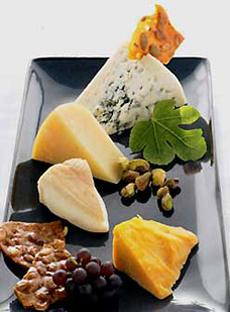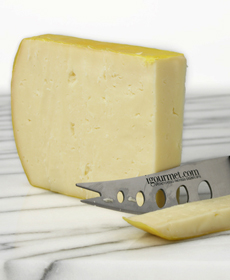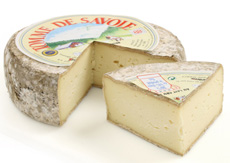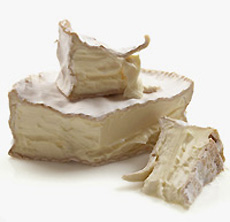
 A beautiful selection of table cheeses is the perfect end to a fine dinner. Photo courtesy of Wisconsin Milk Marketing Board. A beautiful selection of table cheeses is the perfect end to a fine dinner. Photo courtesy of Wisconsin Milk Marketing Board.
May 2005
Last updated April 2015
|
|
Cheese Glossary
Types Of Cheese, Information, Terms & Definitions Every Cheese Lover Should Know
Page 11: Cheese Terms Beginning With T
This is Page 11 of a 12-page glossary of cheese information. Click on the letters below to find terms of interest. When you’re finished with cheese, visit our other food glossaries.
Click on a letter to get to the appropriate glossary page.
a b c d e f g h i j k l m n o p q r s t u v w x y z
This glossary is protected by copyright and cannot be reproduced in whole or part.
TABLE CHEESE
As opposed to a cooking cheese, which gets incorporated into recipes (mozzarella and ricotta, for example), a table cheese is cheese meant to be eaten at the table—as part of a cheese plate, on a sandwich or a burger, etc. See photo above left.
TANGY
A descriptive term describing a cheese’s flavor as sharp, distinctive, flavorsome.
TERROIR
Pronounced tur-WAH, the French word for soil, land or terrain. The term is used to convey the larger concept “of the land,” i.e., how the specific place where an agricultural product is produced bears the taste of that particular piece of land, its specific soil composition and microclimate. In the case of cheese, the grass and other vegetation upon which the animals graze impart flavor nuances to their milk. The same animals, transported five miles away to graze in other pastures, would produce milk with different nuances of flavor that would be reflected in the flavor of the cheese.
TEXTURE
A cheese’s texture can be soft, firm, supple, waxy, open, close, etc. Texture is largely dependent on moisture content: the softer the cheese, the higher its moisture content.
TILSIT
|
Tilsit is named after a town in East Prussia, Germany. It was invented by Dutch immigrants trying to recreate Gouda. Due to local bacteria, molds and yeast in a damp cheese cellar, they couldn’t recreate Gouda, but instead ended up with a brand new cheese, similar to Havarti. Tilsit is a washed rind cheese made from partially skimmed and pasteurized cow’s milk. It is semi-firm with a springy, elastic texture, dotted with irregularly spaced tiny holes. It was traditionally made in large wheels, but is now made in loaf form, making it easier to slice (the way it is generally eaten). The rind is washed and brushed regularly for the first two months of aging to form an outer crust that keeps its supple, smooth interior from drying out.
|
|

Dutch Tilsit and German Tilsit are both available at iGourmet.com. |
Tilsit has a mildly pungent aroma and a tangy taste—delicate and fruity with spicy notes. A good melter, it is excellent on sandwiches (regular and grilled), burgers, and also can be melted over potatoes and other vegetables.There are Danish and German Tilsits. Danish Tilsit, also known as Tilsit Havarti, has a fuller and more intense flavor than Dutch Havarti (and is more yellow in color), but is milder than German Tilsit.
TOME or TOMME
|
A name for a small or medium-size rustic wheel or mountain cheese. The term originated in the Haute Savoie region of France (the French Alps). Tommes are typically produced from the skimmed milk left over after the cream has been removed to produce butter and richer cheeses (or when there is too little milk to produce a regular cheese). As a result, they are generally lower in fat than other cheeses. Tommes are usually identified by their place of origin: Tomme de Beaujolais, Tomme de Savoie etc. In the Haute Savoie, the word tomme also implies that a cheese is made from the milk of more than one herd.
|
|

The best-known tomme is Tomme de Savoie, a simple and robust cheese known for its exceptional quality. the Savoie (Savoy) department in the French Alps. Enjoy it with sausages, fruit, bread and Rhone wine. Available at iGourmet.com. |
TRIPLE-CRÈME CHEESES
|
Cream is added to the milk to create the richest, most buttery group of cheeses. Triple crèmes are a type of bloomy rind cheese and also are aged about two weeks. In order to qualify as a triple-créme, the cheeses must have more than 72% butterfat content, which provides the smooth texture. As with other cheeses that have short aging periods, the flavors are mild and the aromas are subtle. Examples include Brillat-Savarin, Explorateur and St. André. This group of cheeses pairs well with Champagne and other sparkling wines.
|
|

You can taste the creaminess of this Brillat-Savarin, just by looking at the photo. It’s great with Champagne. Available at iGourmet.com. |
TYROSINES
These small, crunchy white crystals are a crystallization of the amino acid, tyrosine, a result of the breakdown of casein (the main protein in milk) as the cheese ripens. They’re perfectly fine to consume—in fact, some people purchase tyrosine supplements, which are believed to reduce stress and help sleep. Certain aged cheeses, like Gouda, Gruyère, Parmigiano-Reggiano and Piave Vecchio, will have a preponderance of them. Most cheese lovers consider the crunchy texture one of the delights of the cheese.
TUROPHILE
A lover of cheese. The word comes from the Greek words for cheese, tyros, and lover, philos. The love of cheese is turophilia.
Continue To Page 12: Terms Beginning With U To Z
Go To The Index Above
Lifestyle Direct, Inc. All rights reserved. Some material copyright Murray’s Cheese. Images are the copyright of their respective owners.

|




 A beautiful selection of table cheeses is the perfect end to a fine dinner. Photo courtesy of Wisconsin Milk Marketing Board.
A beautiful selection of table cheeses is the perfect end to a fine dinner. Photo courtesy of Wisconsin Milk Marketing Board. 

